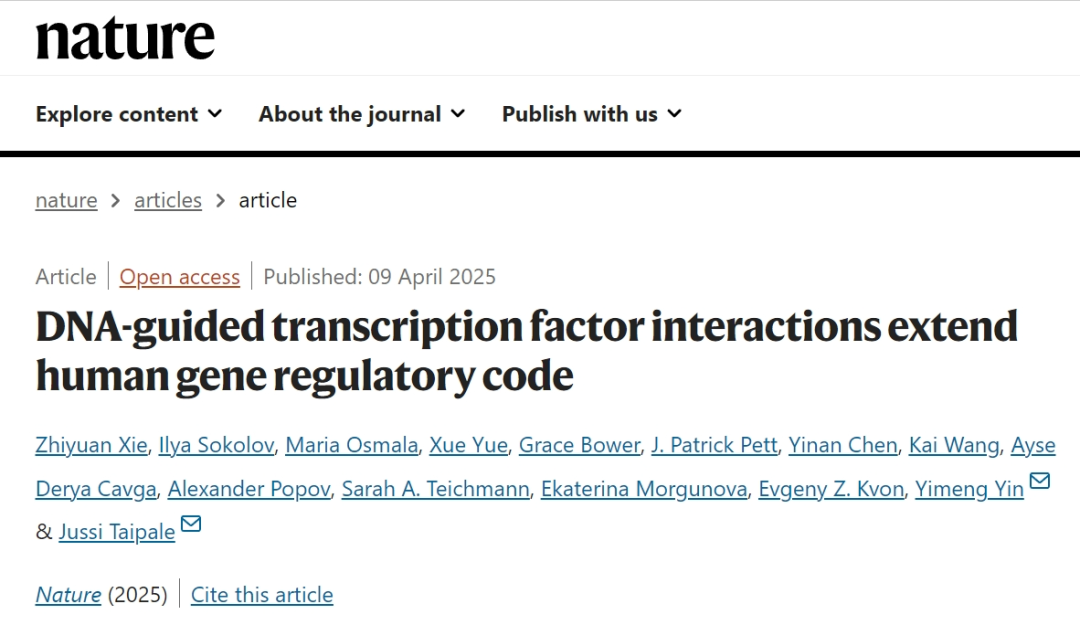A groundbreaking study by Tongji University researchers has shed new light on the molecular origins of developmental abnormalities and diseases like cancer.

Published in Nature on April 9 at 23:00 Beijing time, the study titled "DNA-Guided Transcription Factor Interactions Extend Human Gene Regulatory Code" reveals novel mechanisms governing gene regulation. The research was conducted jointly by Professor YIN Yimeng’s team at Tongji University School of Medicine and the National Key Laboratory of Cardiovascular Disease at East Hospital Affiliated to Tongji University, in collaboration with scientists from the University of Cambridge.
This research breaks from the traditional model focused on single transcription factors regulating genes. It demonstrates that different transcription factors frequently cooperate synergistically to recognize novel regulatory codes, participating in life activities such as embryonic development. Furthermore, mutations in these novel codes are closely related to the occurrence of developmental abnormalities or diseases like cancer.
All the information required for human growth and development is encoded within the human genome. Transcription factors often interpret the diverse information contained in different DNA sequences through synergistic interactions, regulating the spatiotemporal expression of genes and participating in all cellular life activities. Mutations in transcription factors or the DNA sequences they recognize often lead to developmental abnormalities or cause various diseases, including cancer.
Using high-throughput CAP-SELEX technology and computational biology methods, the research team systematically evaluated whether over 58,000 transcription factor combinations (TF–TF pairs) could bind synergistically to DNA. They identified 2,198 pairs of synergistically interacting transcription factors and analyzed the DNA motifs recognized by these cooperative pairs (Figure a). Further in-depth research revealed that these synergistic interactions between transcription factors cannot currently be predicted by artificial intelligence tools like AlphaFold (Figure b). Therefore, the study provides the most comprehensive database to date of transcription factor synergistic interactions, along with the library of DNA motifs they recognize, offering crucial data support and a theoretical basis for scientists exploring the various biological functions of transcription factors.
The team also found that synergistic interactions cause changes in the DNA sequences recognized by more than 800 pairs of transcription factors. Experiments using gene-edited mice confirmed that the novel DNA sequences recognized by synergistic transcription factors can drive the cell-specific expression of key genes, playing a critical role in determining cell fate during early development (Figure c).

This study expands our understanding of the human genome's regulatory code to a higher dimension. It confirms that synergistic transcription factors guide the cell-specific expression of key genes by interpreting these novel regulatory codes, thereby controlling highly spatiotemporal biological processes such as early embryonic development. The discovery of these novel regulatory codes provides new avenues for personalized treatments for developmental abnormalities and various diseases, including cancer.
Tongji University is the primary (first-author) affiliation for this work. Professor YIN Yimeng from Tongji University and Professor Jussi Taipale from the University of Cambridge are the co-corresponding authors. XIE Zhiyuan, a researcher from Tongji University School of Medicine and East Hospital Affiliated to Tongji University, and Dr. Ilya Sokolov from the University of Cambridge are the co-first authors. The research received funding from the National Natural Science Foundation of China (NSFC), the Ministry of Science and Technology (MOST), and support from the Tongji University Brain and Spinal Cord Clinical Research Center.
Paper link: https://doi.org/10.1038/s41586-025-08844-z
